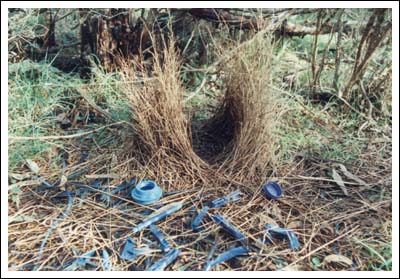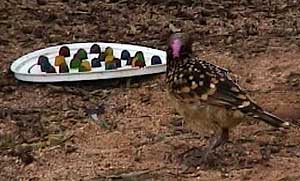Bowerbirds: Nature's Interior Designers
Biology 342 Fall 07
Valerie Conrad and Hannah Smith
Adaptive Value
The Benefts of a Bower to Male and Female Bowerbirds
 [6]
[6]
Increasing complexity of bowers has been linked to a decrease in sexual dimorphism, suggesting that a benefit of having a complex external display is the reduction of bright signals on the body that can increase predation. This theory, known as transfer hypothesis, proposes that female attention transferred from the male’s body to the bower, with the reliability of bower quality as an indicator of good genes being the proposed driving force.
Basing mate choice on bower quality is beneficial to female bowerbirds because bowers provide an accurate means of identifying good genes and determining male fitness, due to the difficulty and complexity of creating and maintaining an attractive bowers. It has also been theorized the bowers were originally an outgrowth of a display of male foraging ability.Female preoccupation with bower building can be at least partly explained by the pressing need to identify good genes, due to the fact that bowerbirds are polygynous, with no contribution to raising the young by the male. It is believed that bowers are a superior indicator of male genetic fitness, in comparison to plumage, because of the difficulty of constructing a bower large and intricate enough to win a mate. Construction materials, sometimes weighing half as much as the bird itself, must be brought to the bower site, and incorporated into the structure, and hundreds of ornaments must be found and arranged. Together these tasks indicate both physical skills such as strength, endurance, and the ability to manipulate objects in a complex fashion, and mental faculties such as memory and the ability to discern between objects and arrange the pleasingly. Additionally, male bowerbirds must be able to defend their edifice from theft and destruction by neighboring males, while simultaneously attacking other bowers to disadvantage the competition and stealing ornaments to improve their own. Because quality of an individual male’s bower increases with age, males with ornate, well-constructed bowers are necessarily older, and therefore posses genes that have allowed them to survive well into maturity.
 [2]
[2]
Bowerbird participating in color-choice experiment.
It has been suggested that the male bower display evolved by taking advantage of preexisting foraging behavior and co-opting it as an indicator of genetic fitness. When given a choice of artificially colored grapes, females preferred colors that correlated with male building preferences (Madden and Tanner). This could indicate that by using highly valued foodstuffs as building materials, males demonstrated their foraging abilities and abundance of resources, hence improving their attractiveness as a potential mate. However, the correlation between male and female color preferences has been disputed, as Borgia and Keagy found an inverse relationship between ornament color and food color preferences. From their data, they hypothesized that original bower decorations were inedible, and possibly reflected the scarcity of that color in the surrounding environment, as possessing large amounts of a rare color-- often blue-- is demonstrative of desirability.
Bowerbuilding benefits males by creating the possibility of siring a large numer of offspring, and by increasing resource availability.
Progeny
Bower building is advantageous to males because it creates an opportunity for males to be wildly successful at perpetuating their genes, so that although a very small number of males actually succeed in reproducing, those that do so have an extremely large number of offspring.
Resources
Bowerbirds also eat mainly fruit, and therefore excrete ingested fruit seeds in the immediate vicinity of their bowers. This makes perennially occupying the same bower sites distinctly advantageous, as it creates a concentration of fruit trees, which in turn allows males to spend less time foraging for food and more time perfecting their bowers.